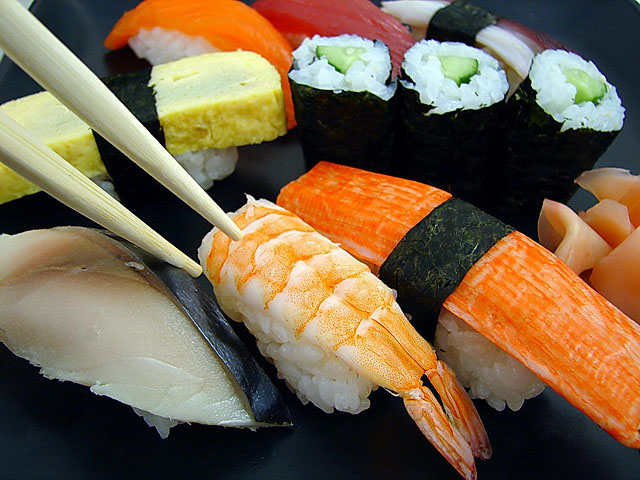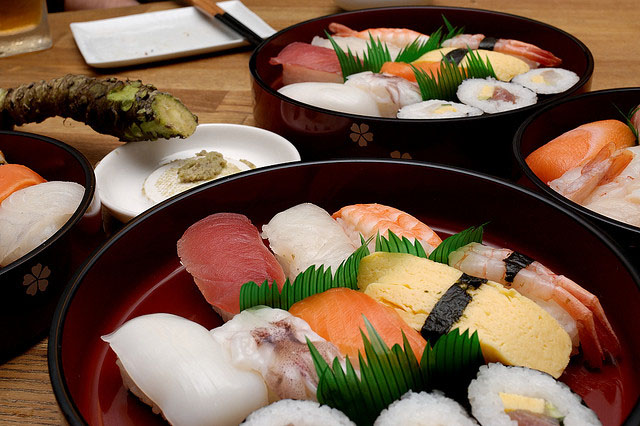Crazy for Japanese Food Delivery: How to Eat Sushi Like a Boss
Posted by Kimberly B. on Tuesday, September 16th, 2014 with 9 Comments

There’s a wide variety of choices with nigiri: fried egg, cooked shrimp, and salmon are all great sources of protein, and look beautiful placed atop sushi rice.
Image source: Flickr user Tony Gladvin George
When it comes to food, the question of comfort still very much applies: how do we know when it’s time to push ourselves to try something new? While it’s nice to stay settled in our culinary comfort zones, taking some edible risks is well worth our while. Sure, we could stick with ordering American food delivery like healthy sandwiches, but what about the myriad flavors from other cultures just waiting to be explored?
Japanese food is a great place to begin a new tasty adventure, with its light, healthy cuisine that uses different ingredients and flavors than American foods. There’s something for everyone here: In addition to sushi, most Japanese restaurants also offer other traditional Japanese dishes, such as chicken, wheat noodles, salads, and soups. And don’t worry if some people on staff are averse to raw fish; there are topping options like cooked shrimp, cucumber maki, or fried egg instead.
The art of Japanese food
Depending on the chef, both sushi and its appropriate dining etiquette can vary greatly from restaurant to restaurant. For example, if you were to eat at world famous sushi chef Jiro Ono’s restaurant in Japan, it would not be acceptable for you to add extra soy sauce or wasabi. Jiro, known to many as the best sushi chef in the world, would have already put the ideal amount onto the sushi prior to serving. In his restaurant, he knows best. He would also choose the type of sushi for you based on his daily menu.
But sushi bars like Jiro’s are not the norm in America (nor even in Japan); most restaurants that we’re likely to order food delivery from will be more conducive to a casual, social style of eating — perfect for an office meal. We can put on however much sauce we want; choose to eat our maki and nigiri rolls with either our hands or chopsticks; and scope out who has the best — and worst! — chopstick technique.
And yet, with great power comes great responsibility. If we’re in charge of the type of sushi we order, how much condiments we put on, and how we eat it, it’s only fair that we brush up on our sushi skills a little.Let’s bring our understanding of this delicious Japanese cuisine up a notch from beginner to intermediate by taking a closer look at the ins and outs of sushi, along with some great ideas for the tastiest types to order for your office.
Choosing sushi wisely
If you’ve ever seen a sushi menu before, the sheer variety of options available can sometimes feel overwhelming. Plus, names like maguro (tuna) and ebi (shrimp) are difficult to understand if they’re not subtitled. But do not fear! There is a happy medium between sticking with the tried-and-true Western style rolls (like the California roll and spicy tuna roll) and eating raw octopus. Here is a sushi selection that will give everyone in the office a taste of Japan.
Maki: For the picky or hesitant eaters in your office, be sure to order some simple types of these traditional rolls wrapped in nori. Maguro rolls (tuna) for simple protein; kappa rolls (cucumber) and kampyo rolls (marinated sweet strips of gourd) for the vegetarians on staff; and some futomaki or kamikazi rolls for an element of surprise. These usually vary between restaurants, as they’re often a serendipitous concoction made from whatever fresh ingredients happen to be on hand.
Nigiri: This is a good style of sushi (a mound of sushi rice adorned with a topping) to be a little more experimental with. Order some tamagoyaki (fried egg) for those who aren’t comfortable eating raw fish; sake nigiri (salmon) for a familiar flavor and healthy fats; ebi nigiri (cooked shrimp) and white shiro maguro (albacore tuna) for the seafood fanatics on staff; and some unagi (broiled freshwater eel) for those who want something different. Chances are the unagi will be cooked with a sweet sauce, which also increases its appeal for people who might otherwise be reluctant to try eel.
Other types of sushi: In addition to the usual maki and nigiri, there are plenty more sushi styles with which to impress the office foodies. Try ordering a smattering of these: Tamaki (nori-wrapped hand-rolls) in both salmon and tuna offer employees healthy oils and nutrients in a tasty, hand-held treat. Meanwhile, gunkanmaki and meharizushi are other worthwhile variations on sushi: the latter is a ball of sushi rice wrapped in nori, while the former is wrapped in a type of mustard leaf called Tekana. There’s also sasamaki and inarizushi — sushi wrapped in a bamboo leaf, and fried tofu, respectively.

With so many sushi varieties, there’s bound to be something to please everyone on staff.
Image source: Flickr user syvwlch
The great wasabi mystery
The most common sushi-related myth involves wasabi. The truth is that most Japanese restaurants in the West (or even Japan, for that matter) don’t serve real wasabi! What we have come to think of as wasabi — the green, tangy paste that we dab sparingly onto sushi) is actually horseradish mixed with mustard seed flour and food coloring. Since most of us have never tasted real wasabi, and instead have grown accustomed to the horseradish version, it doesn’t make much difference to our sushi-eating experience. Nonetheless, it still begs the question: what is real wasabi? It turns out that the wasabi plant, called Wasabi Japonica, is more expensive than horseradish and grows much more slowly, making it a less economical choice for restaurants: “Even in Japan horseradish is often used in place of Wasabi japonica.” Thought to have medicinal properties, real wasabi “only holds its strong flavor for about 15 minutes after preparation.” This means that the root needs to be grated shortly before serving, making it impractical for food delivery orders, and restaurants where the chefs can’t guarantee the sushi will be eaten by the customers within a short period of time.
A well-rounded Japanese meal
Now that we have a sushi delivery order that will make everyone excited for Japanese food, let’s review some of the basics: Remember to use the ginger as a palate cleanser between bites of sushi; don’t be afraid to put the whole sushi in your mouth — it’s meant to be eaten all in one go; lightly dip sushi into soy sauce to taste with either hands (for maki) or chopsticks; and feel free to enjoy as much or little wasabi as you like (otherwise known as horseradish). To round out an amazing sushi-centric, Japanese food delivery experience, consider adding some Japanese drinks and desserts to the table. If work has been going particularly well, treat employees to some traditional Japanese desserts such as Maju — sugary dumplings with various fillings — and uiro, sweet steam cakes that come in flavors like strawberry and green tea. Conversely, if it seems that employees have been feeling overloaded and fatigued, Japanese matcha tea might be just the thing to re-invigorate tired staff. Now a popular health drink in many parts of the world, matcha tea is known to boost energy and immune systems.
Office meals are a perfect opportunity to explore new cuisines and cultivate connection between employees through shared culinary experiences. There really is a wealth of choices when ordering Japanese food delivery that will get everyone in the office excited. So don’t take the easy way out with food delivery — step out of your comfort zone and order some delicious new cuisines this week! Waiter.com is available to help make your Japanese food delivery a success among all employees.
What are your favorite types of sushi to order — do you have any more recommendations? Have you ever tried real wasabi? Let us know in the comments!
When it comes to feeding employees and coworkers, make your company's food program really count! If your workplace dining plan needs to take it up a notch — or if you don't have one at all — Waiter.com is here to help. From Virtual Cafeteria Service to diverse menus to local takeout & delivery, Waiter.com offers customizable dining solutions for every business and budget. Contact us today to get started!

I agree with the fact that one must explore the varieties of flavors available to our palates. The Japanese cuisine is definitely a great place to start with so many complex and exciting flavors, it is one that is sure to get your taste buds wanting more!
Hi Branda, thanks for your thoughts. You’re right about Japanese food — it is filled with so much variety that it’s near impossible to tire of!
I found it interesting the article because I am someone who loves sushi. This blog has made me want to push the boundaries of what I normally order and try out some new types of food
Hi Melissa,
Thanks for reading! Happy you found the article valuable. Sushi is one of my favorite foods, too! Have fun stepping out of your comfort zone; there are so many fantastic types to try.
this article is great. i never knew the proper way to eat sushi cant believe i was doing it wrong all this time!!
Hi Mike! Glad you found the article useful. When it comes to proper sushi-related manners, it helps to get tips from the pros on YouTube every now and then — good luck! 🙂
I never knew that about the wasabi (or should I say horseradish)! I’m not a big sushi eater, but I think I’ll take some of the suggestions here and give it another try. The food in those pictures looks delicious!
Hi Lori, thanks for reading. Yes, isn’t it surprising that wasabi has been a myth all along? I’ve never tried the real stuff myself, but would like to. Enjoy experimenting with more sushi!
I have always found sushi to be a fascinating food. Besides the fact that it tastes great, there is so much history and culture that revolves around it. I also love that there is a certain type of etiquette involved, meant to show respect for these highly trained sushi chefs.